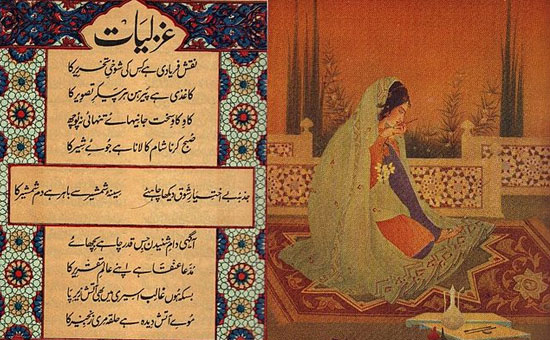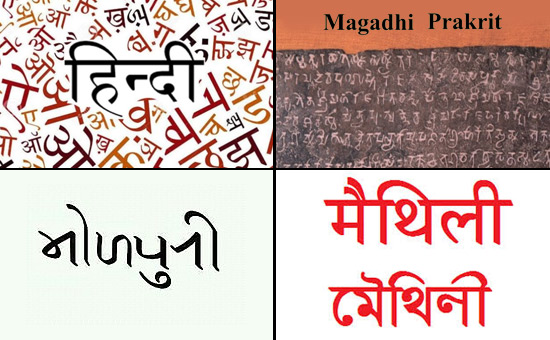- How do non-Hindi speakers learn Hindustani? Development of Hindustani is linked to Urdu so briefly know history of Urdu before & during British rule. Why Hindustani is linked to the Hindi Revival Movement started by the Arya Samaj? Impact of Hindi on languages of Bihar. Know words borrowed by Marathi!
During
the last few weeks, in the news is controversy over learning and speaking of
Hindi in the states of Maharashtra, Karnataka and Tamil Nadu.
Recently,
Chief Minister of Andhra Pradesh Shri Naidu supported speaking of Hindi. Since
today, what is spoken is Hindustani and not Hindi people of undivided Andhra
might not have a problem because large parts of the state speak Hindustani by
virtue of having a Muslim ruler in the Nizam. Plus Urdu had its origins in
Hyderabad.
Most do not know
that Bollywood movies are Hindustani not Hindi movies. “In the 1950s Urdu language played a dominant role in the songs of that era as the front-ranking poets and lyricists of that time, Sahir Ludhianvi, Kaifi Azmi, Majrooh Sultanpuri wrote in Urdu.” Source
Barring Shailendra, who was from Bihar and wrote more in Hindi.
So,
what is Hindustani?
Simply
put Hindustani = Hindi + Urdu AND Urdu = Persian and Arabic, even though it
originated in India.
Impact on non-Hindi speaking states like Maharashtra, Gujarat,
Odisha
People
in these states pick up spoken Hindi more from Bollywood and TV serials/news.
Since they speak Hindustani people adopt language thinking speaking Hindi. Mind
out Hindustani has no script.
Recent Thackeray Cousins function in Mumbai titled Aawaz Maharashtriacha. Now Aawaz is an
Urdu word. Google search says it is Persian in origin.
Like-wise
many foreign words have become part of Marathi language. Note that Aap, an Urdu
word, is not used in Marathi where we say Tumhala.
Understand meaning of names Bharat (Hindi) and Hindustan (Urdu)
The word Bharata i.e. Bha means light and knowledge and rata means devoted. Bharata means devoted to light and in a spiritual sense it means knowledge of inner self attained by removing ignorance. Bharata is also the name of an ancient King whose name means ‘one who is capable of nourishing and protecting’. The word 'Bharat' is also used in the Holy Gita and refers to Arjuna as the best, foremost among the Bharata dynasty. Refer chapter number/slokh 3.41, 7.11, 7.16, 8.23, 14.12 and 18.36.
Hindustan means ‘Urdu speaking areas of the Indian sub-continent’ and excludes a substantial part of modern day India for e.g. Tamil Nadu.
In brief, history of Urdu in India till British came.

1. The word Urdu is derived from the Turki word Ordu, which meant “a military camp”. During the period 1526 to 1707 it was called Dakhina and used in the Deccan and South India.
2. The chief
centers of Dakhni literature were Gujarat, Golconda, Bidar, Bijapur and
Aurangabad. It was patronized by amongst others Qutb Shahi Sultans of Golconda,
one of whom, Muhammad Quli Qutb Shah was a gifted poet. One of his courtiers
wrote a romantic poem whose theme was love of this king for a Telegu Hindu girl
named Bhagwati whom he later married, named the city built in her honor as
Bhag-nagar, subsequently renamed as Haider-Begum. Thus
the name Hyderabad.
3. As the
religio-ethical and socio-economic health of the Muslim community came to be
adversely affected by the weakening of the Mughal rulers, the intelligentsia
felt the need to revitalize the Muslim morale by means of religious reforms.
And Arabic became the natural medium for fulfilling the requirements of
religious rethinking among the Muslims in the early part of the 18th century.
This could also explain the influence of Arabic on Urdu.
4. Urdu is Hindi
Khari boli (Delhi Hindi) with Persian and Arabic thrown in. Although the
language came into existence after 1730 it is only after 1818 did it become a
language for expressing thoughts.
5. Its main centers
of influence were Delhi and Lucknow.
6. Persian was the official language of India
till 1837. Urdu, which later became the dominant language of education and
administration, came only with the establishment of British rule over Punjab.
7. Starting the 20th century Urdu became a bone of contention between Hindus and Muslims. The compromise was Hindustani i.e. Hindi and Urdu. For details read History
of Urdu
It
was from 1818-1905 that Urdu developed into a language of expression for
religious, philosophic thoughts. Sir Syed Ahmed and Muhammad Iqbal did a lot to
make it the lingua franca of the Indian Muslims.
The
Arya Samaj (founded by Gujarati Swami Dayanand Saraswati) led a successful a
Hindi revivalist movement in Punjab, Uttar Pradesh and Rajasthan.
As
time passed by Urdu came to be seen as the language of the Muslims. Evidence
given by Muslim leaders before the Hunter Commission (between 1883 to 1890) in
Bengal demanding entire separate arrangements for the primary education of Hindus
and Muslims and insisting upon Urdu as a medium of instruction even in a
province like Bengal where 99 % of the Muslims were ignorant of that language.
The
founder of the Arya Samaj Swami Dayananda Saraswati (1875) used to communicate
in Sanskrit till he met a leader of the Brahmo Samaj Shri Keshub Chandra Sen
who stressed the importance of carrying on his propaganda in a popular
language. So Dayanand decided to propagate his teachings in Hindi. Since the
Arya Samaji movement had strong roots in Punjab, Hindi became Arya Bhasa there.
Impact of the Arya Samaj Movement to revive Hindi
The
impact of the Arya Samaj is also to be seen in the adoption of Hindi as a language
of administration in Rajputana and U.P. Dayanand wrote all his works in Hindi
or Sanskrit. Under the persuasion of Sir Pratap Singh, several states of
Rajputana were convinced to adopt Hindi script for official work. It came to be
adopted as an alternative medium of administration in U.P. early in the 20th
century.
What
complicated matters further was the Hindi Urdu controversy originating from a
movement by the Hindus of Kashi in 1867 to replace Urdu by Hindi and the Arabic
script by Nagari.
Another
Hindi Urdu controversy erupted in 1900. It was the practice in Uttar Pradesh
that all petitions to the court must be written in Urdu. The Hindus protested
against it forcing the government to pass an order on 8/4/1900 that Government
offices and law-courts should also entertain petitions written in Hindi and
Devanagari scripts and that court summons and official announcements would be
henceforth be issued in both Hindi and Urdu.
Urdu
got caught in the Hindu Muslim crossfire that got accentuated after Khilfat
movement.
When
the Hindus insisted on use of Hindi, the League denounced it as a sign of Hindu
domination and could not think of co-operating with the Congress unless Urdu
was made the national language in place of Hindi. That too when Urdu was
nothing but a Persianized dialect of Hindi. Its script is Persian and the
grammar is of Hindi.
The
Congress effected a compromise. A new hybrid
language half Hindi half Urdu named Hindustani was created.
Impact on languages of Bihar etc.

From
the beginning of the 20th century the people have accepted a form of western
Hindi, actually the Khariboli speech of Delhi, as their language of education,
literature and public life. It became the national language while Maithili,
Magahi, Bhojpuri, Awadhi, Bagheli, Brajabhasa, Chattisgarhi with other central
and western Himalayan dialects being described as dialects of Hindi.
Effective
literary development of Hindi started only after 1850. Prior to 1850, when we
said Hindi literature it meant Brajbhasa the most important form of western
Hindi. Read How
a Bihari lost his mother tongue to Hindi
Today we are arguing over the speaking of Hindustani not Hindi. If Sanskrit were made India’s National Language such issues might not have arisen because there is a bit of Sanskrit in all languages of South India.
Foreign
invaders destroyed temples of North India but the South still has them so we
remember. So also, colonisers created Hindustani so we forget Hindi but many North
Indian states have kept Hindi alive so we remember.
To
realize the beauty of Hindi hear someone like Ashutosh Rana speak it (is from
Madhya Pradesh)
To my mind Hindi and state languages can co-exist and blossom.
Always happy to stand corrected.
References
This
article is based on inputs of volumes 7 to 11 of the History and Culture of
Indian People published by the Bhartiya Vidya Bhavan.
Also read
1.
Hindi
binds People of Arunachal Pradesh like Fevicol
2.
How
a Bihari lost his mother tongue to Hindi
3.
History
of Hindi
4.
History
of Urdu
5.
The case for making Sanskrit India’s National Language
6.
Hindi, Hindustan and Hindu
7.
Samskriti,
Sanskrit and Indonesia
There are hundreds of words from Persian and
other languages which are now intrinsically embedded into marathi and are fully
considered as marathi. आवाज is just one of them. A Marathi speaking friend sent me a short list below -
*मूळ फारशी भाषेतून मराठीत आलेले शब्द:*
सतरंजी, पेशवा, रवानगी, अत्तर, कामगार, मोहोर, लष्कर, फडणवीस, सामना, लेजीम, बगीचा, गुन्हेगार, खानेसुमारी, रसद, शाई, अबकारी, कारभार, शाहीर, हजार, सरकार, चाबूक, शौकीन, वजन, हप्ता, महिना, खबरदार, शिरस्ता, खातरजमा, दिलासा, नजराणा, दौलतजादा, नेस्तनाबूत वगैरे.
*मूळ अरबी भाषेतून मराठीत आलेले शब्द:*
अर्ज, इनाम, मंजूर, दौलत, बातमी, हुकूम, साहेब, खर्च, मेहनत, जाहीर, कलम, नक्कल, सरबत, फाजील, जबाब, उर्फ, उस्ताद, पैज, शान, जाहीरनामा, मजबूत, साफ, शहर, संदुक, नजर, नजाकत, तैनात, तालुका, तालीम, महाल, मदत, तफावत, जकात, वायदा, बदल, करार वगैरे
*मूळ पोर्तुगीज भाषेतून मराठीत आलेले शब्द:*
बटाटा, तंबाखू, कोबी, पगार, इस्त्री, हापूस, फणस, पायरी, साबुदाणा, पेरू, अननस, बिस्कीट, पुरावा, चावी, तुरुंग, पाव, जुगार, पसारा, टिकाव, लवाद, वरांडा, साबण, परात, तिजोरी, काडतूस, बटवा, फीत, शिरपेच, पलटण, पिस्तुल, पाव, कमांडर, लिलाव, नाताळ, बिजागिरी, बादली, टोपी वगैरे.
*मूळ इंग्रजी भाषेतून मराठीत आलेले शब्द:*
डॉक्टर, नर्स, पार्सल, पेन, सायकल, स्टेशन, सिनेमा, ऑफिस, टेलिफोन, मोटर, ग्लास, सर, मॅडम, टीचर, नंबर, पँट, बटन, ड्रेस, तिकीट, पोस्ट, पेशंट, बॅट, बॉल, फाईल, पास, ब्रेक, एजंट, बस, रेल्वे, ट्रेन, टिव्ही, रेडिओ, टेबल वगैरे.
*मूळ गुजराती भाषेतून मराठीत आलेले शब्द:*
दलाल, दादर, सदरा, डबा, भिशी, मावा, ढोकळा, रिकामटेकडा, जेमतेम, खादी, गरबा, दांडिया, चरखा, मथळा, लागवड, इजा, पथारी, आवकजावक, मलमपट्टी, दामदुप्पट, शेट, अफरातफर, झंझट वगैरे
*मूळ कानडी भाषेतून मराठीत आलेले शब्द:*
आक्का, अण्णा, ताई, आत्या, चेंडू, खोबरे, लवंग, गाजर, भाकरी, अडकीत्ता, खलबत्ता, मडके, तूप, किल्ली, आंबील, शिकेकाई, विळी, पेटी, परडी, पगडी, शिंपी, चाकरी, बांबू, सूड, भांडे, भंगार, चिंच, खोली, कोथिंबीर, मिरवणूक, छटाक, चड्डी, चिरगुट वगैरे.